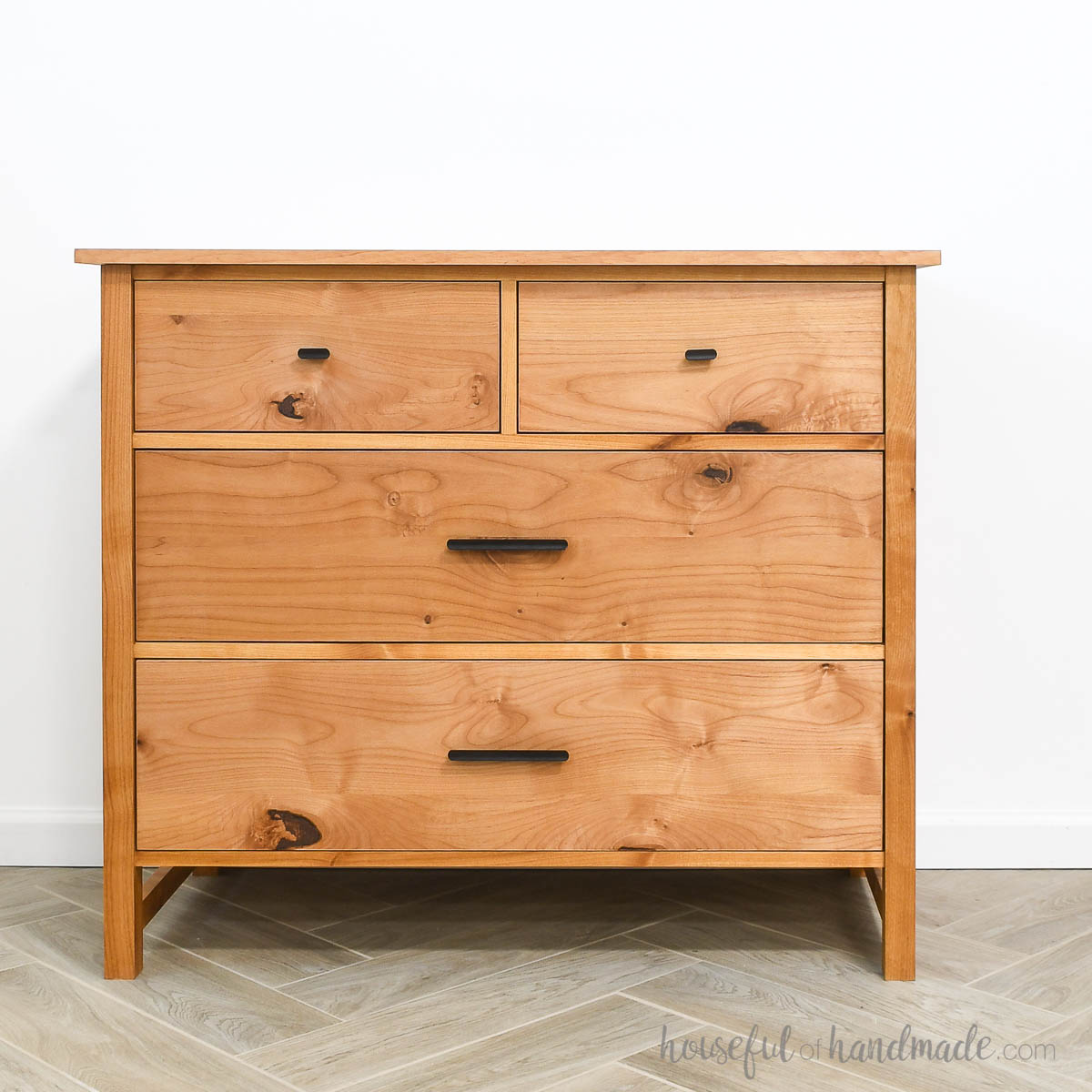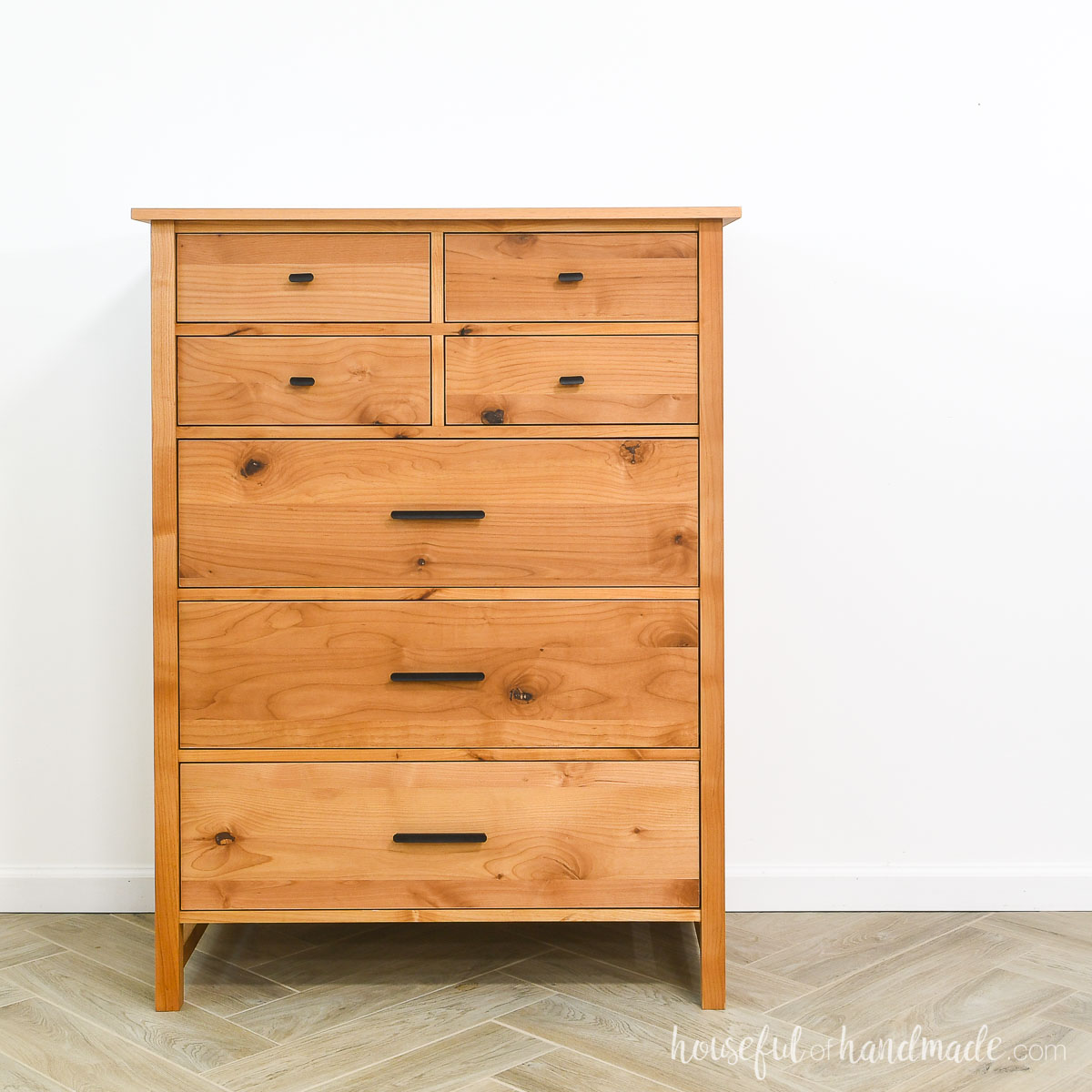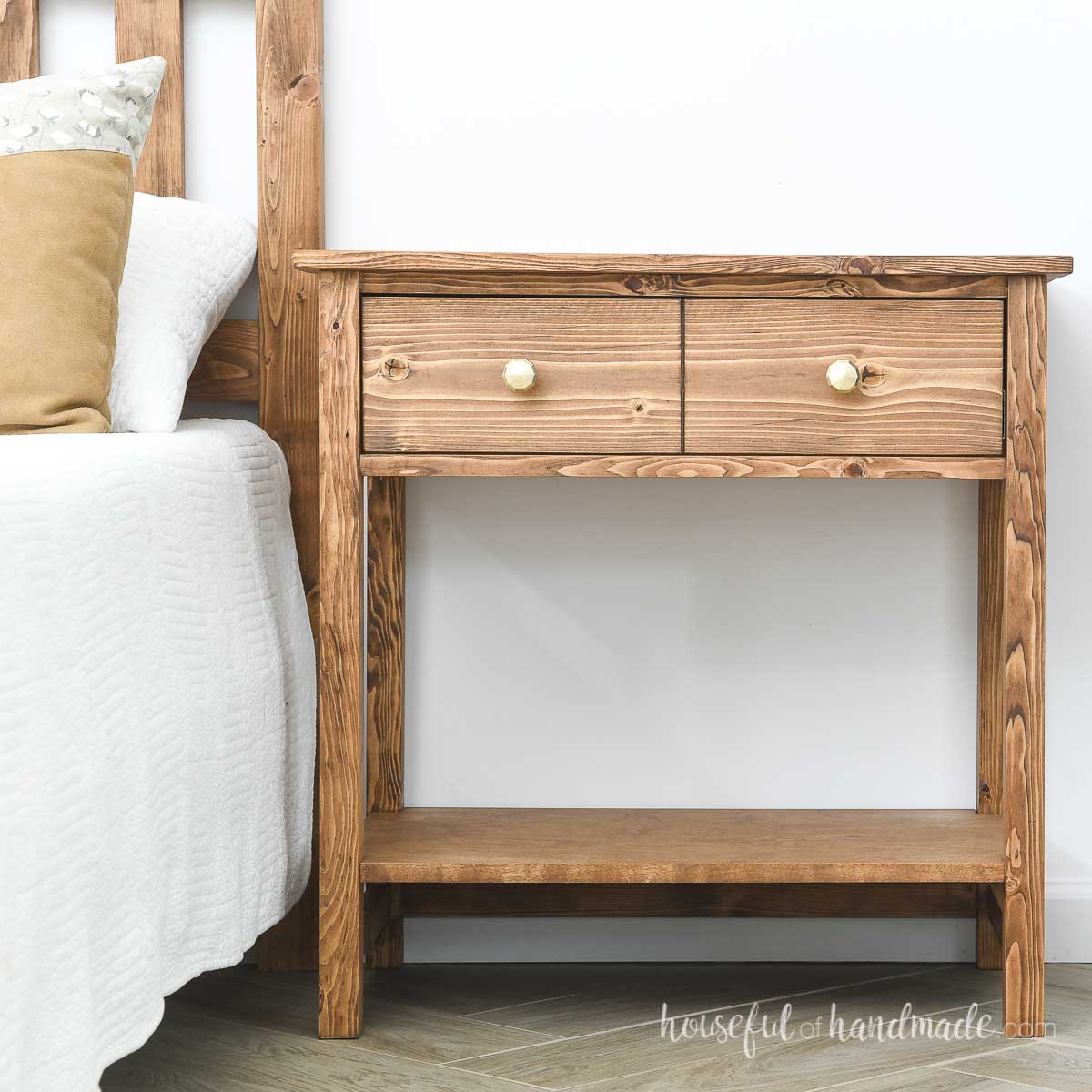If you like having necessities next to your bed, you need a nightstand. And this DIY nightstand has lots of room to store all the things.
With 3 drawers you can keep everything you need for a restful nights sleep close by. But more important, it can be easily hidden in the drawers.
I love how this simple 3 drawer nightstand is the perfect piece to finish off the classic series coordinating bedroom set.
This post may contain affiliate links. As an Amazon Associate I earn from qualifying purchases. Click here to read my full disclosure policy.
Check out the matching 6 drawer dresser plans, 4 drawer dresser, tall 7 drawer dresser plans and 1 drawer nightstand plans to make your own custom bedroom set.
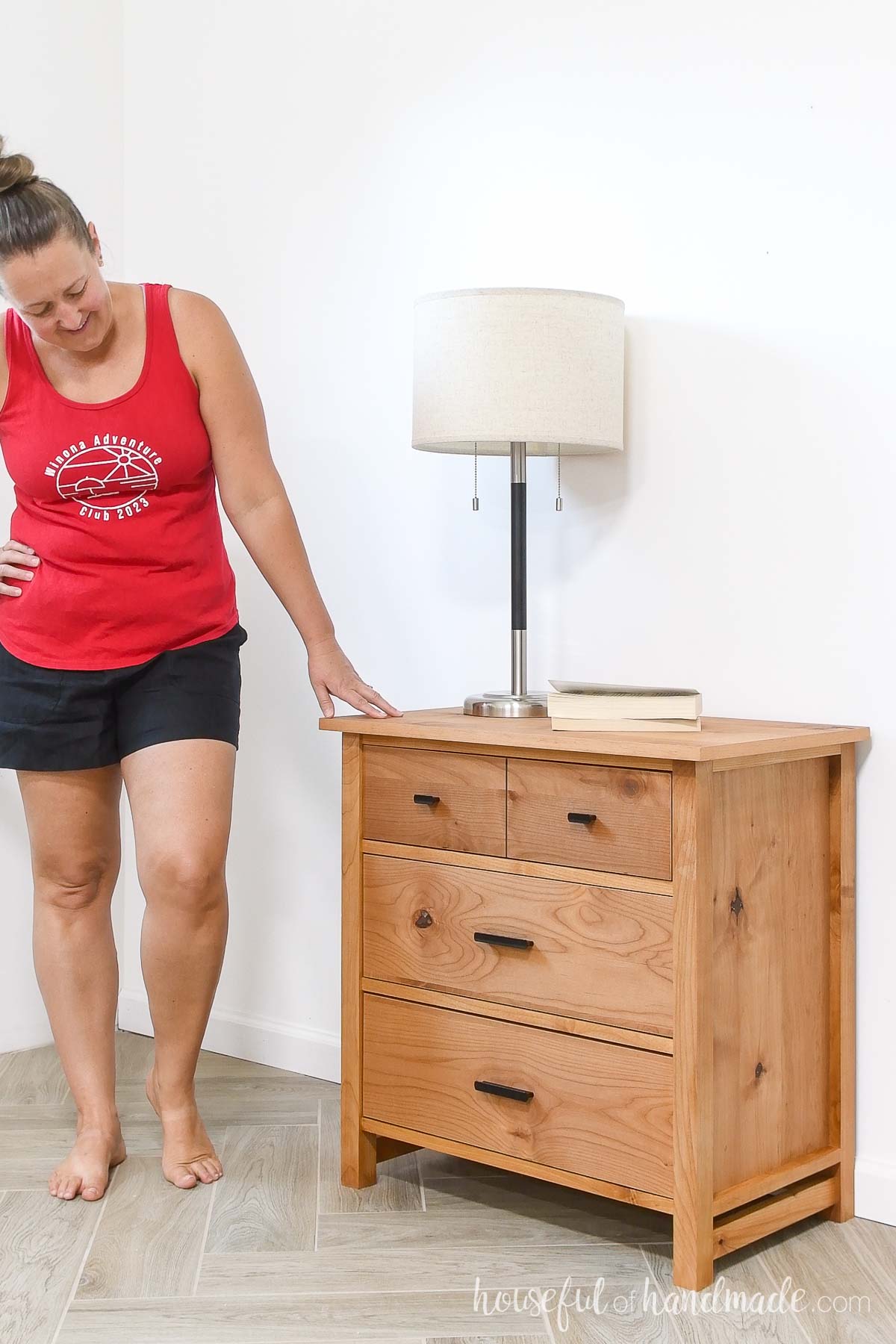
Two Nightstand Sizes
Sometimes it is hard to find just the right nightstand for your room. Big modern bedrooms can make regular nightstands look small.
So I decided to make 2 different nightstand plans: a standard 22″ wide one and a nice big 28″ wide one. You can pick the right sized nightstand for your room.
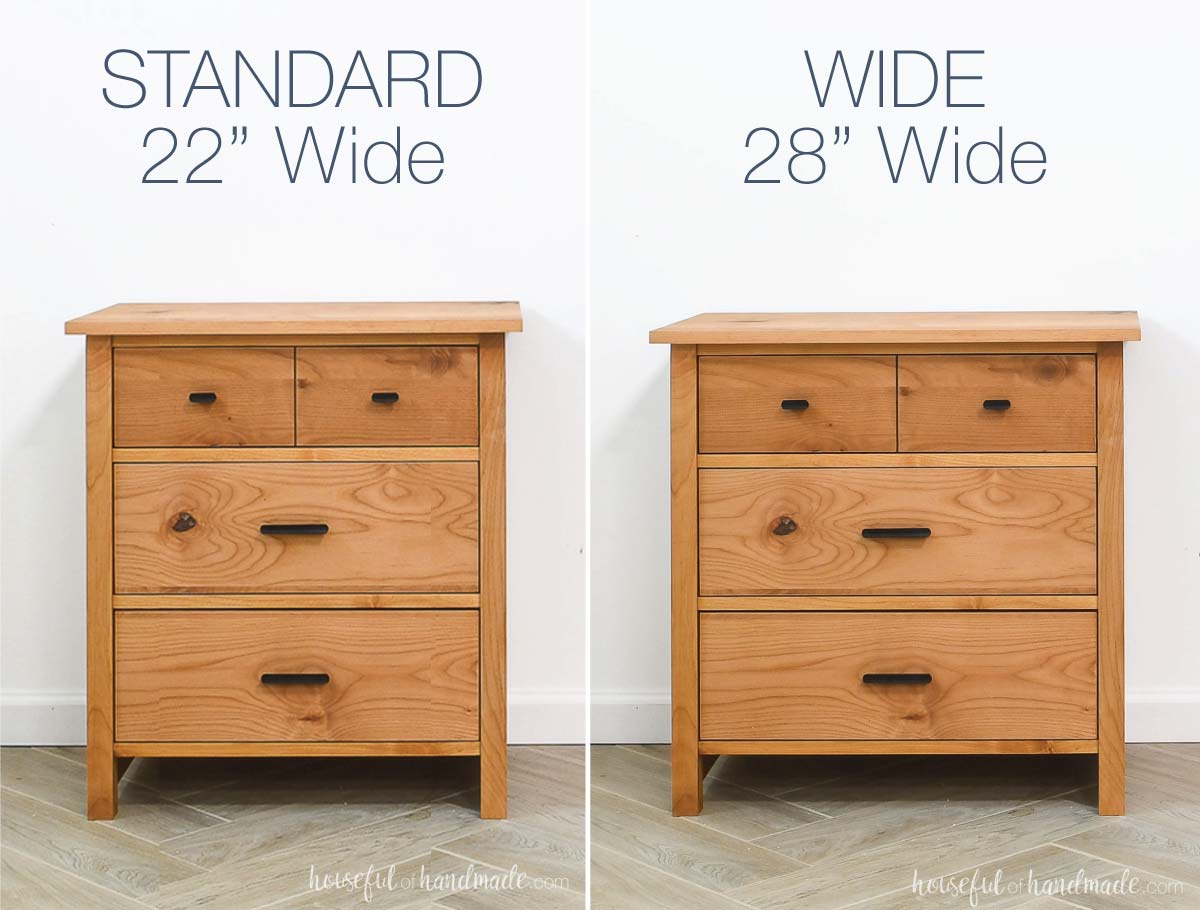
I love the wider nightstand if you have a lot of things you like to keep next to your bed. I usually have my lamp, 1-2 books I am reading, lotion, blue light blocking glasses and a coaster for my nightly tea.
The larger nightstand makes it easy to keep everything at hand!
But if you prefer a clutter-free nightstand (sometimes I wish mine was). Or just need a narrower nightstand so you have room, the standard version is perfect.
The standard nightstand still has plenty of room for storage in the 3 drawers!
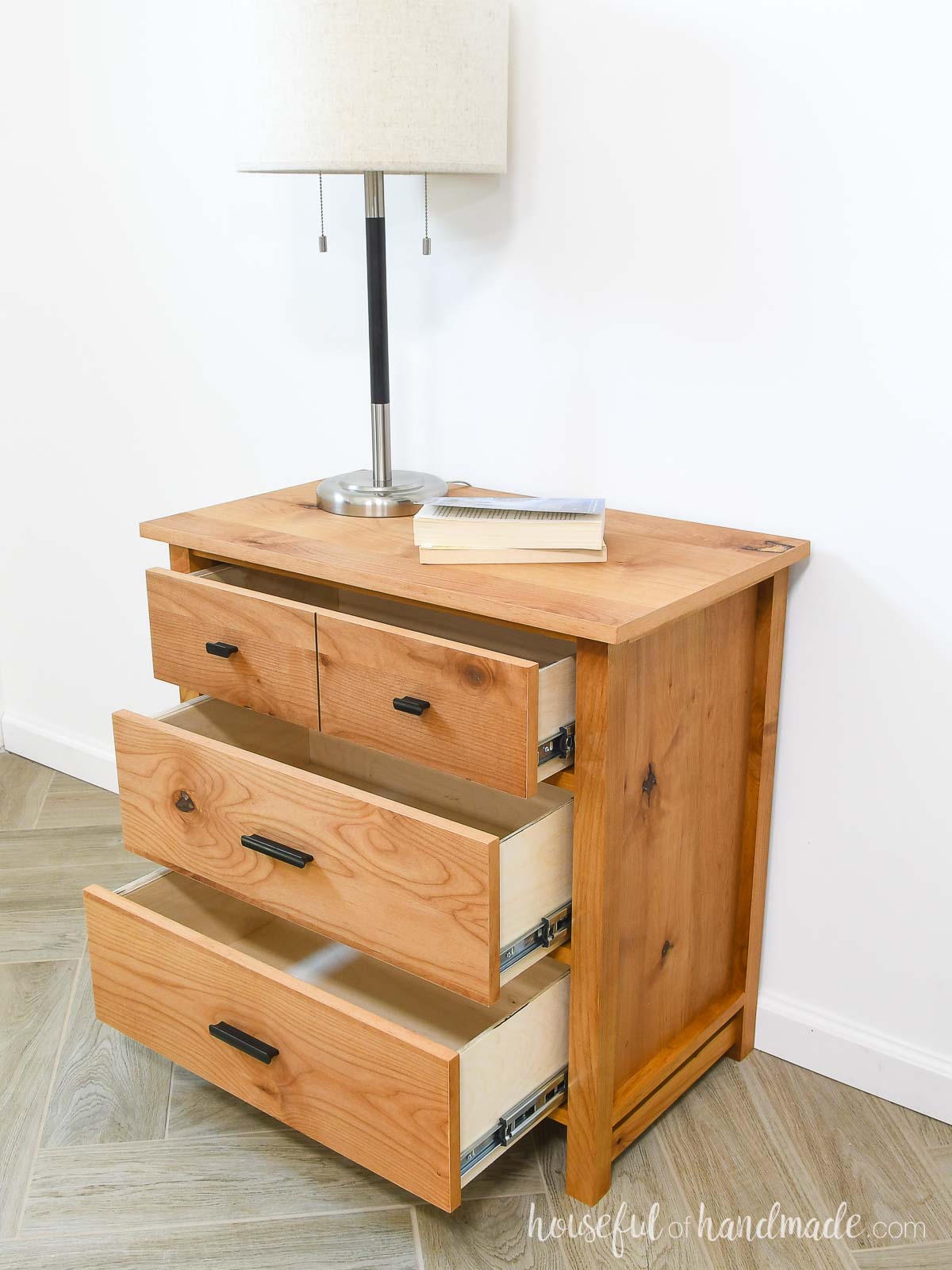
Matching Dresser Set
Need more store in your bedroom? You can build a complete dresser set with a 3 different dresser options and 2 different nightstands.
How to Build a Nightstand with Drawers
Tools & Materials
Recommended Tools:
- Miter saw
- I recently upgraded to this larger sliding miter saw (watch for it to go on sale), but all my projects before were built with this inexpensive miter saw that I loved.
- Circular saw with guide track
- Pocket hole jig
- Drill
- Impact driver (optional, but I love not having to switch bits with the drill)
- Multi-mark measuring tool
- Right angle clamp
- Sander
- Optional: Pneumatic stapler
- Optional: Trim router
- Optional: Brad nailer
Supplies:
- Wood products
- (2) 2×2 boards, 8′ long
- (2-3) 1×2 boards, 8′ long
- (1) 3/4″ plywood, 4×4 sheet
- (1) 1/2″ plywood, 4×4 sheet
- (1) 1/4″ plywood, 2×4 sheet
- Plywood edge banding
- 1 1/4″ pocket hole screws
- 2 1/2″ pocket hole screws
- 1″ wood screws
- 2″ wood screws
- 1″ pneumatic staples or 1″ pocket hole screws
- Wood glue
- (3 pair) 12″ drawer slides
- (3-4) drawer pulls
Overall Dimensions
The finished nightstand is 16 1/2″ deep and 28″ tall. The standard nightstand is 22″ wide and the wide one is 28″.
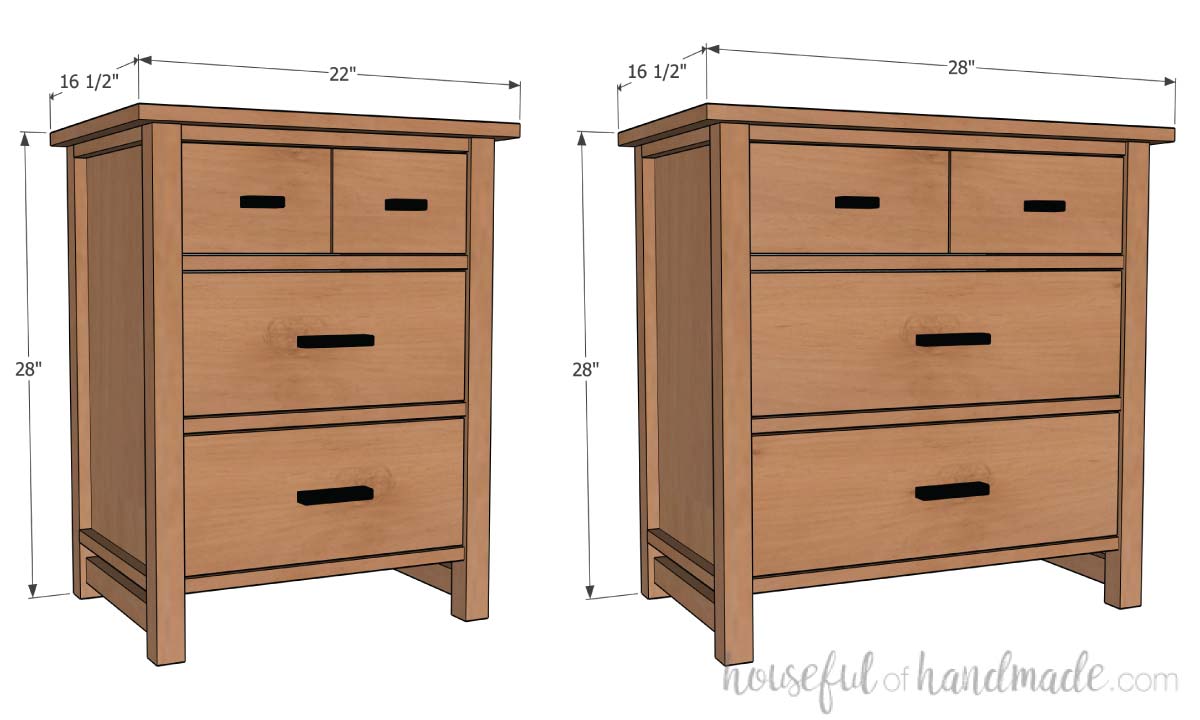
Cut List
Cut out the pieces according to the build plans.
You can find the build plans for the standard 22″ wide nightstand here. Or get the wide nightstand plans here.
I love to break down my plywood sheet on a piece of rigid foam insulation to make sure the sheet and my cut pieces are supported.
I start by using a RipCut guide to cut the plywood into strips, then cross cut the pieces to final length.
Learn all my tips for easily breaking down sheets of plywood with a circular saw here.
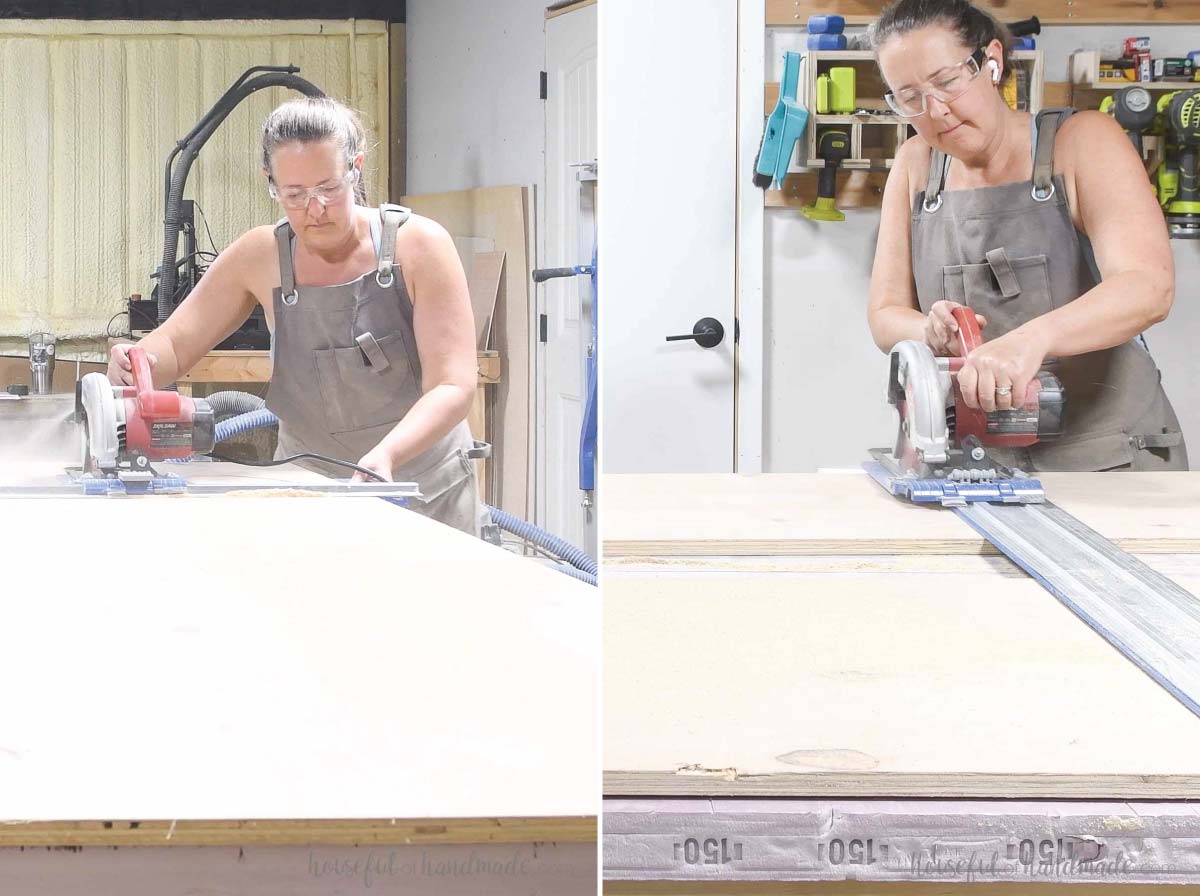
For the drawer fronts and top, iron edge banding around the perimeter of the drawer front pieces to cover the plywood edge.
Alternately, you could cut the drawer fronts from 1×6 (actually 5 1/2” wide) and 1×8 (actually 7 1/4” wide) boards if you prefer solid wood drawer fronts.

To make the top drawer look like 2 drawers, cut an 1/8″ deep groove down the center with either a table or circular saw.
Just one pass with the saw is all you need to give the appearance of 2 drawers. If the plywood is pale in your groove, feel free to add some dark stain/paint to make it look like a gap.
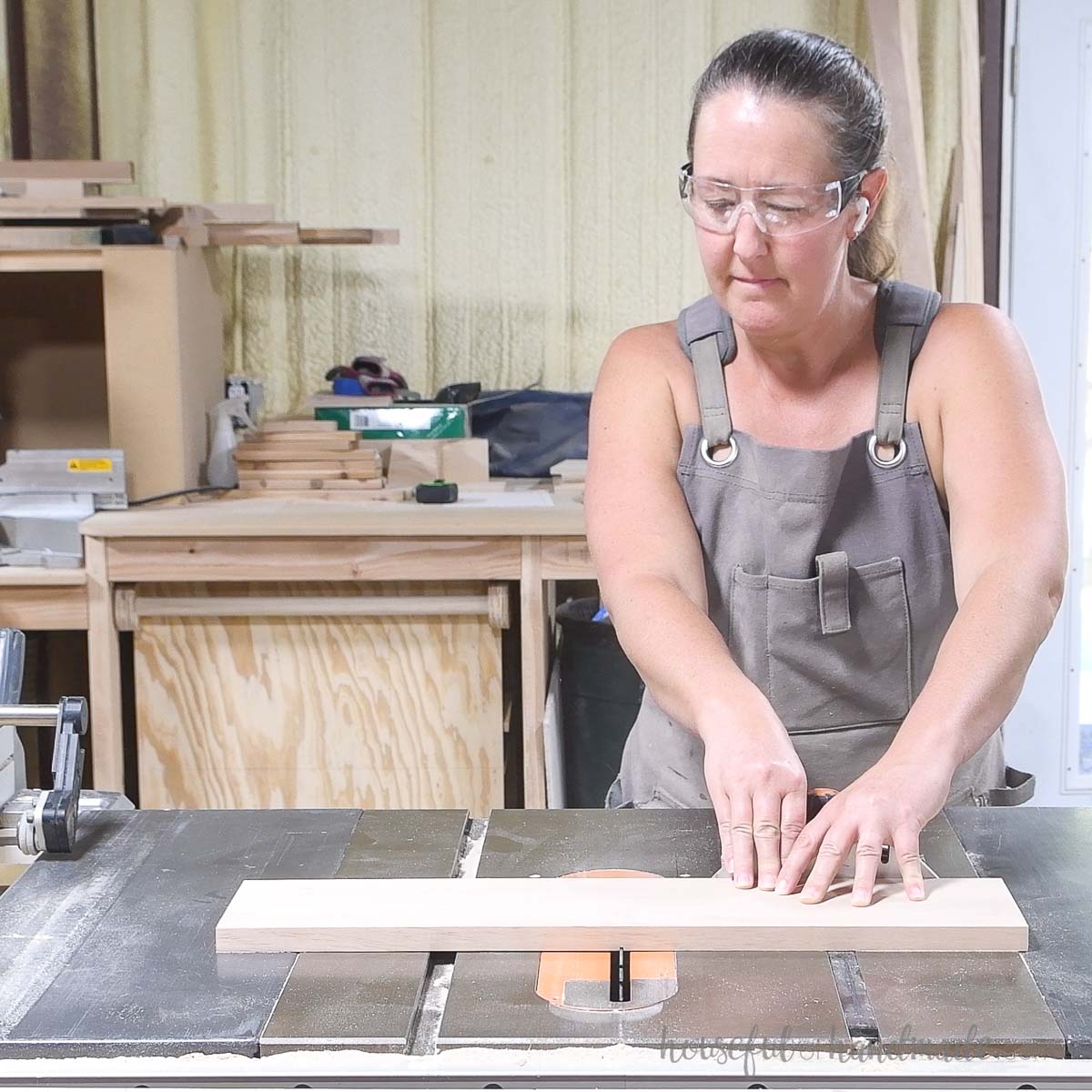
STEP 1- Build the sides
Drill one pocket hole, set for 1 1/2” thick material, in both ends of the 3/4” wide edge of the side trim pieces.
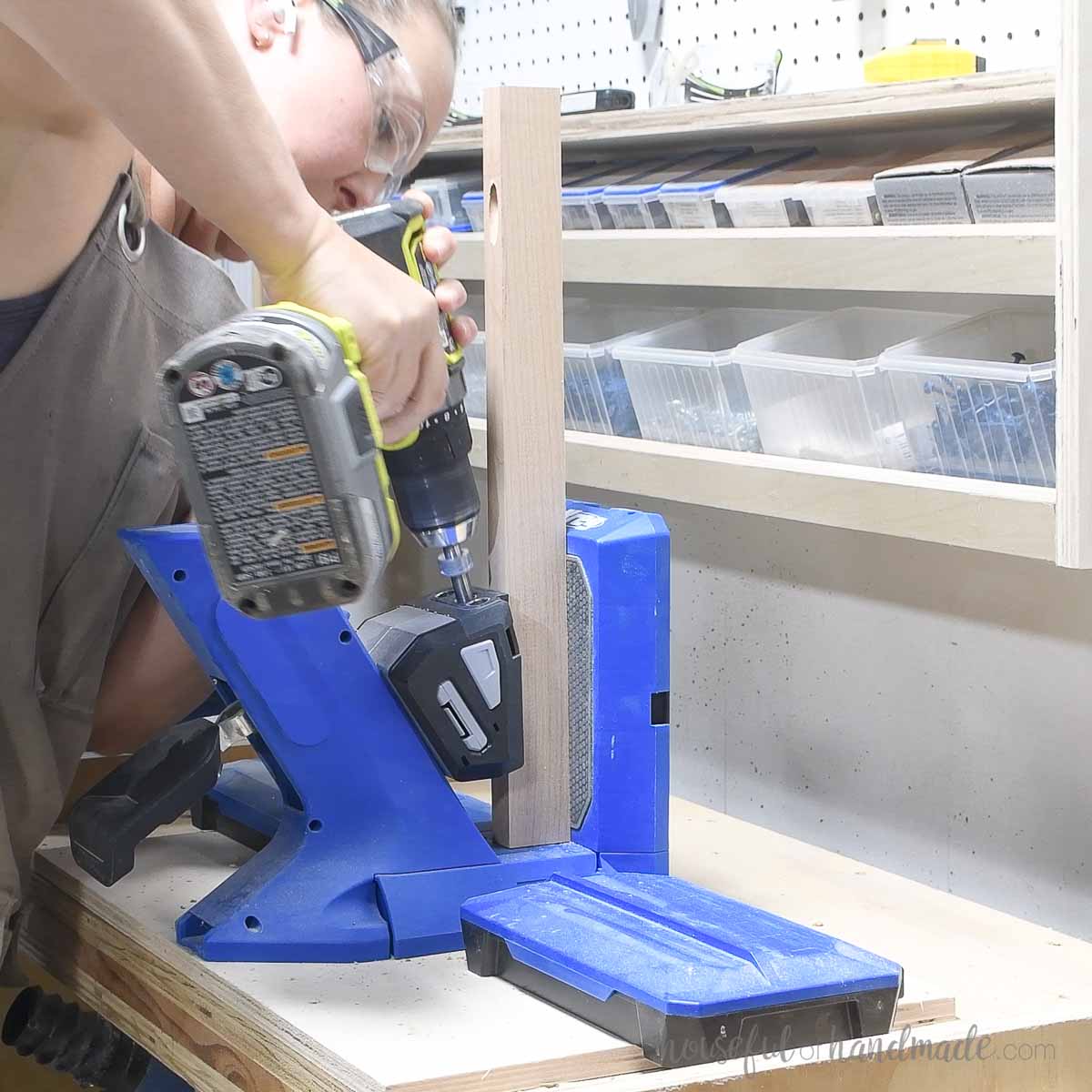
Drill pocket holes set for 3/4” thick plywood in the perimeter in the side panel pieces.
On the top/bottom of the side panel, set the pocket holes in from the edges so they will not be in the way of the pocket holes on the side trim pieces when attaching.
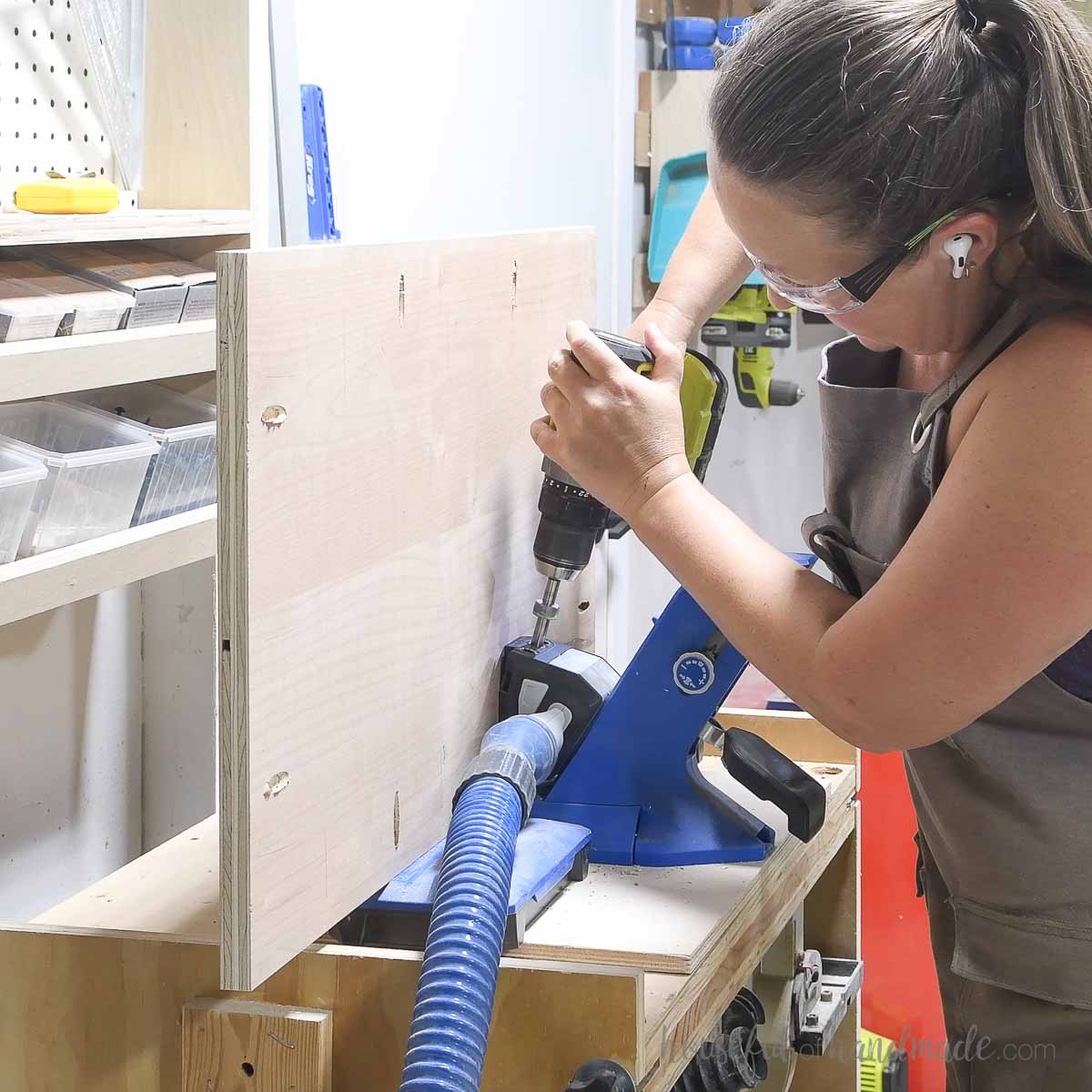
Attach the side trim to the top and bottom of the panel so the panel is flush with the back of the trim board.
Secure with 1 1/4” pocket hole screws and wood glue.

Attach the side panel to one leg piece with wood glue and screws so it is flush to the top and the panel is flush to the back of the leg.
- Use 2 1/2” long pocket hole screws to secure the trim pieces to the leg.
- Use 1 1/4” pocket hole screws to attach the panel to the leg.
Attach the third side trim piece to the bottom of the leg so it is 1” up from the bottom of the leg and centered on the leg (3/8” in from the front and back).
Make sure the pocket hole is on the underside so it is hidden. Secure with glue and 2 1/2” pocket hole screws.
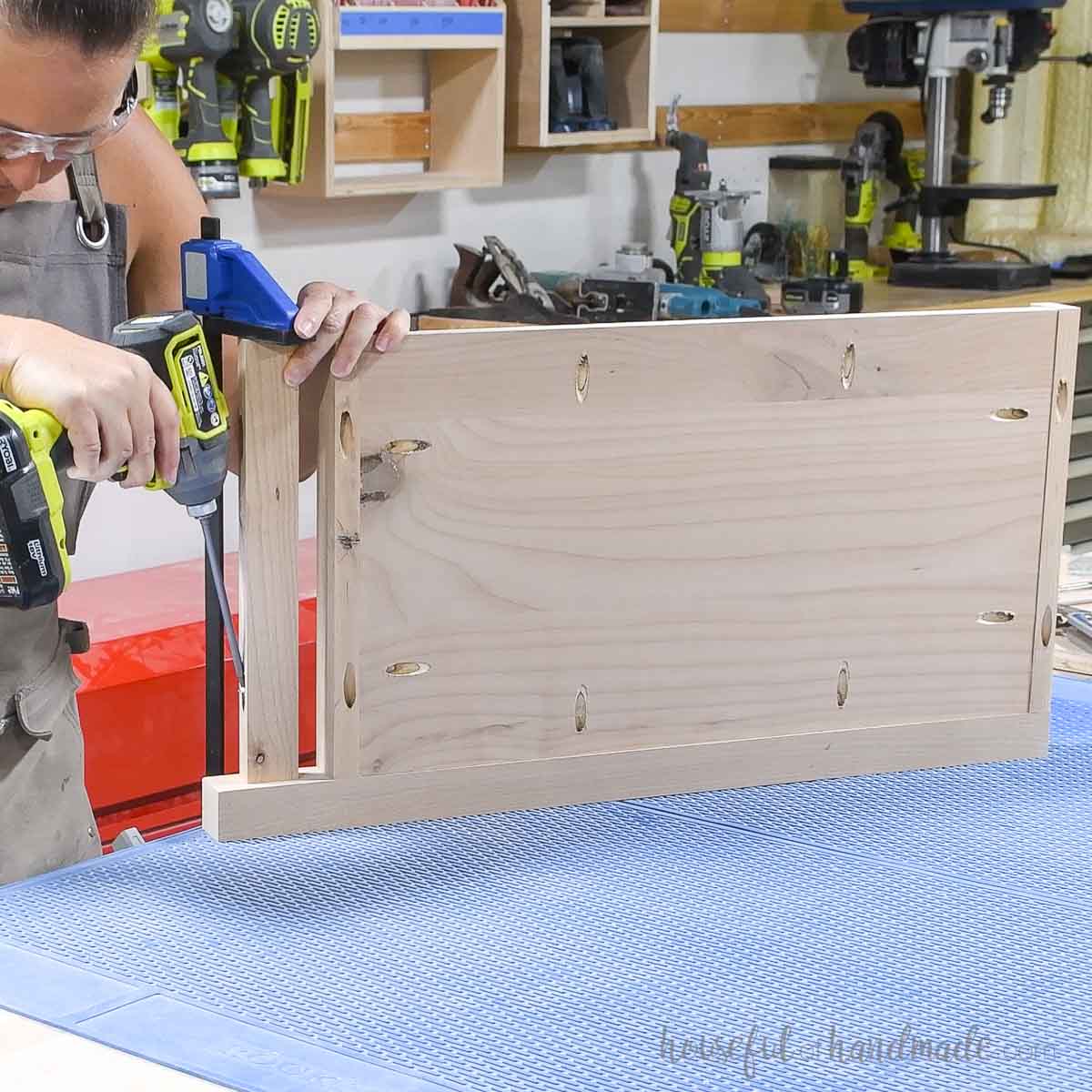
Attach the second leg to the other side in the same way.
The repeat for you have 2 finished sides.
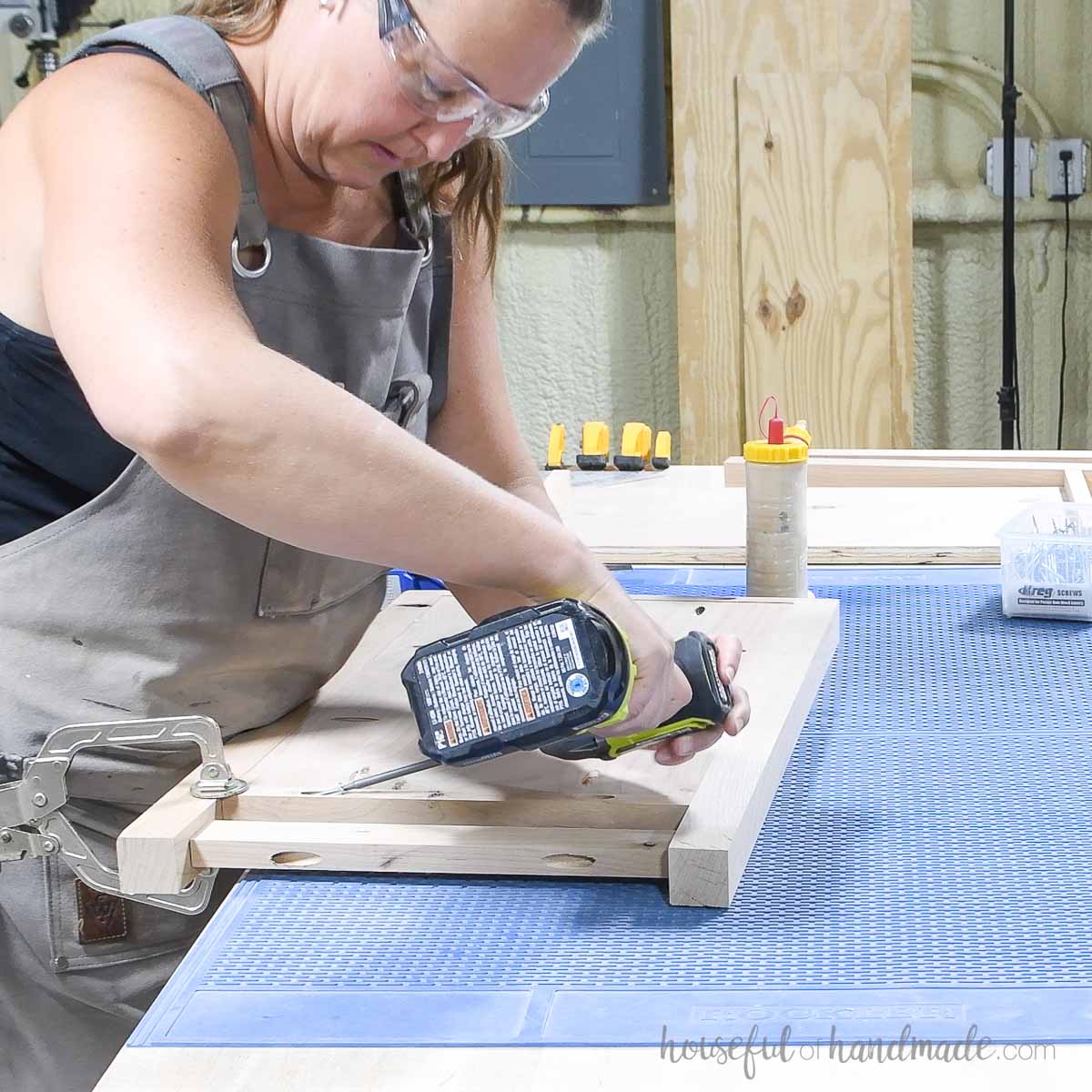
STEP 2- Attach sides together
Drill two pocket holes set for 3/4” thick material in each end of the (4) front trim pieces.
Attach the front trim pieces to one assembled side according to the spacing in the diagram in the plans. Set them back 1/4” from the front of the legs.
Secure with 1 1/4” pocket hole screws and wood glue.
EXPERT TIP:
To hide the pocket holes, face the pocket holes in the top trim up so it is hidden under the top and the pocket holes in the rest of the trim pieces down so they are toward the floor.

Once all the front frame pieces are attached to one side, attach them to the second side piece.
Make sure to match the spacing and secure with 1 1/4″ pocket hole screw and glue.
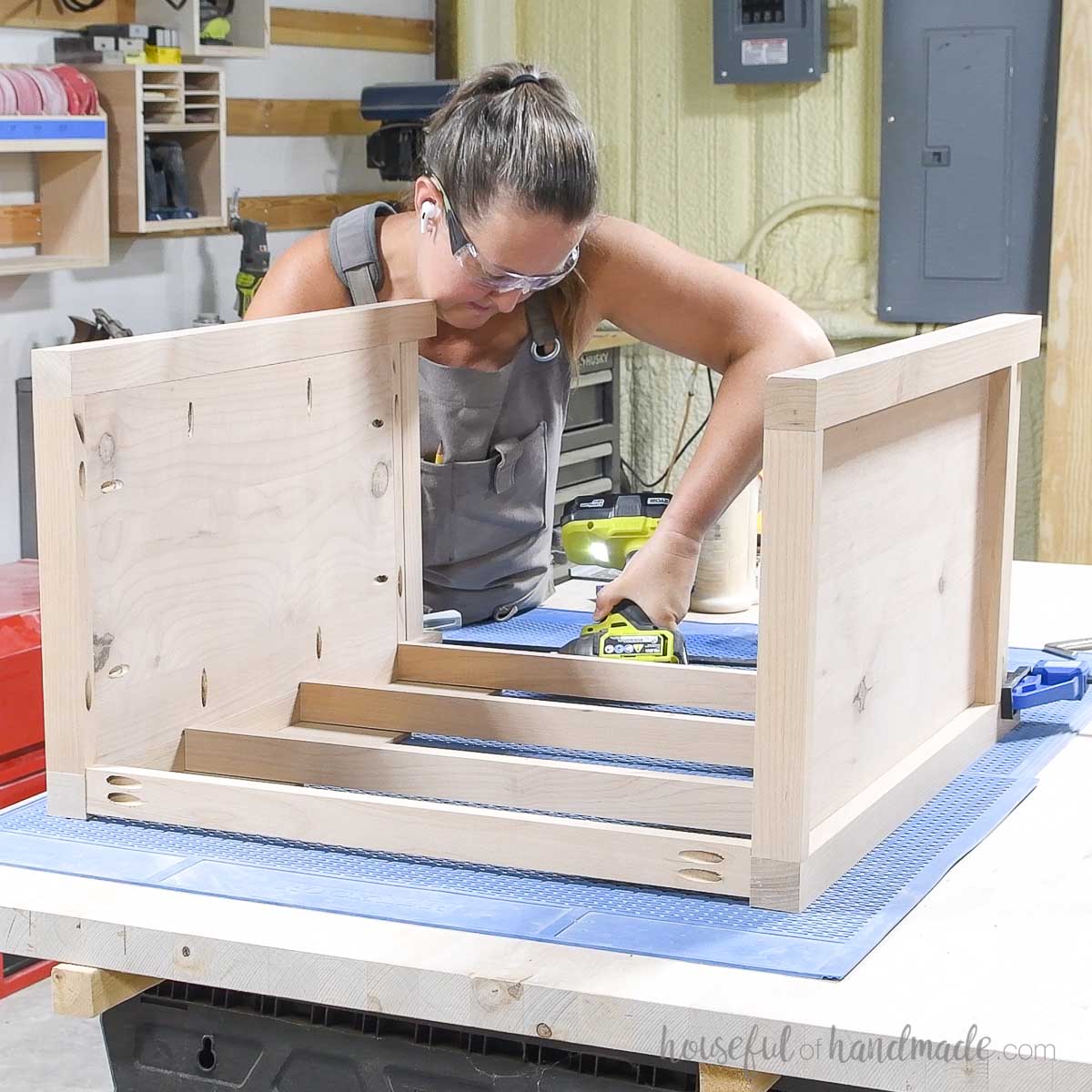
Drill pocket holes set for 1 1/2” thick material in both ends of the back pieces and the 3/4” wide edge of the back trim piece.
Attach the back pieces to the sides with 2 1/2” pocket hole screws according to the 3D drawing in the PDF plans.
Attach the back trim between the sides so it is 1” up from the bottom and centered on the legs (3/8” in from each edge) with the pocket hole on the bottom to keep it hidden.
Secure with wood glue and 2 1/2” pocket hole screws.
NOTE: The back of the dresser is complete. If you want to add a back to cover it up, you can cut a piece of 1/4” plywood to cover it up but it is not necessary for structure. Also, I prefer to have the open back to prevent things from getting stuck behind drawers.
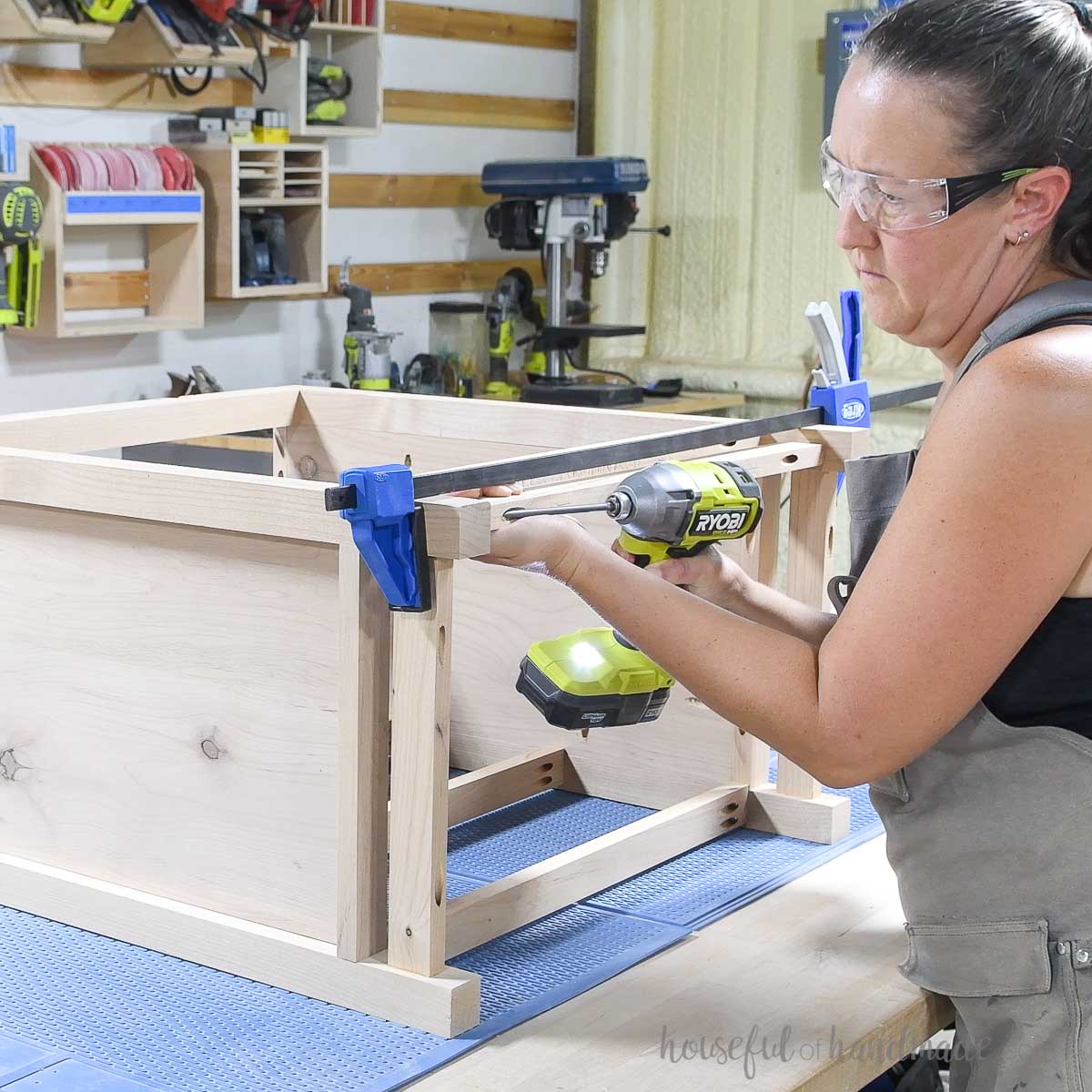
STEP 3- Build drawer boxes
Cut a 1/4″ wide by 1/4″ deep groove in the inside of the drawer box pieces 1/4″ up from the bottom.
I did this by taking multiple passes with my table saw. You could also use a circular saw or router to add a groove.

You can assemble the drawers with pocket holes or pneumatic staples. If using pocket holes, drill pocket holes set for 1/2″ material in the outside sides of the drawer box front and back pieces (not the same side as the groove).
Build the drawer boxes by securing the side pieces to the front pieces with wood glue and 1″ staples or pocket hole screws.
Make sure the top of all the drawer box pieces is flush.
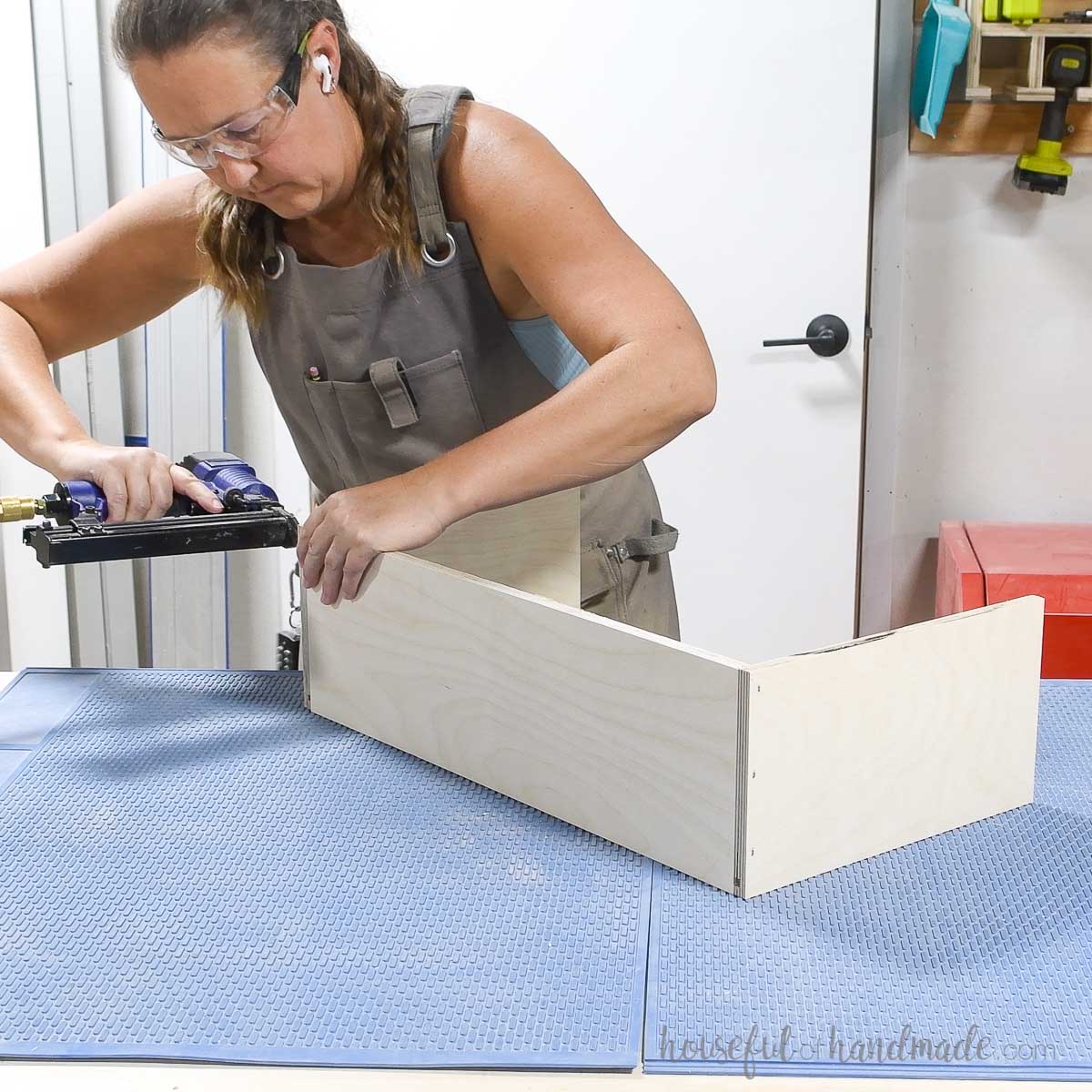
Slide the drawer box bottom piece into the groove on the sides and front. Then attach the back piece the same way you did the front to enclose it.
Repeat for all (3) drawer boxes.
Find tips and additional ways to build drawer boxes here.
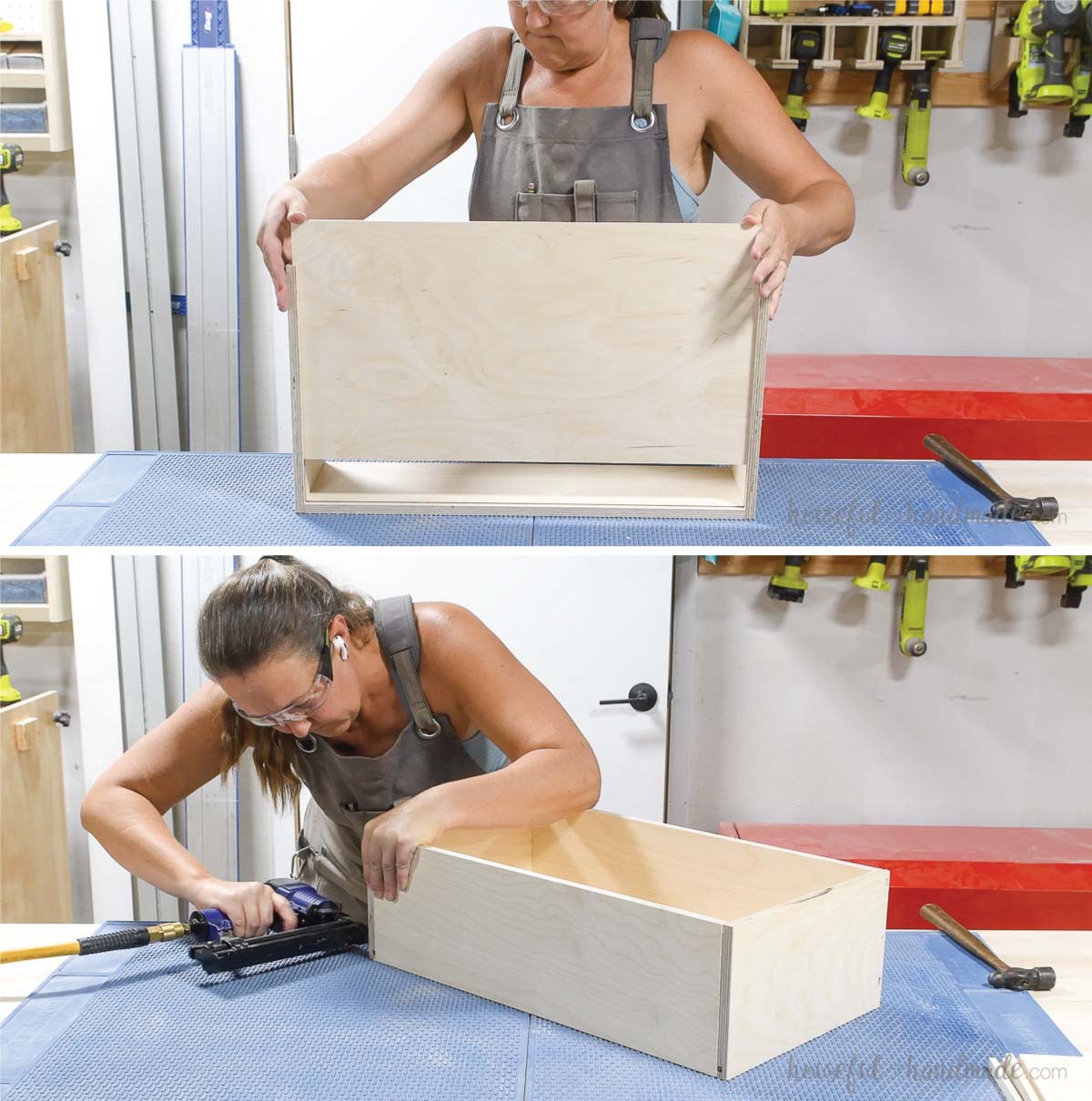
I like to round over the inside of the drawer box to remove the sharp edge of the plywood. This step is totally optional, but is easy to do with an basic trim router and a round over bit.
Or you can smooth the inside edge with a sander.
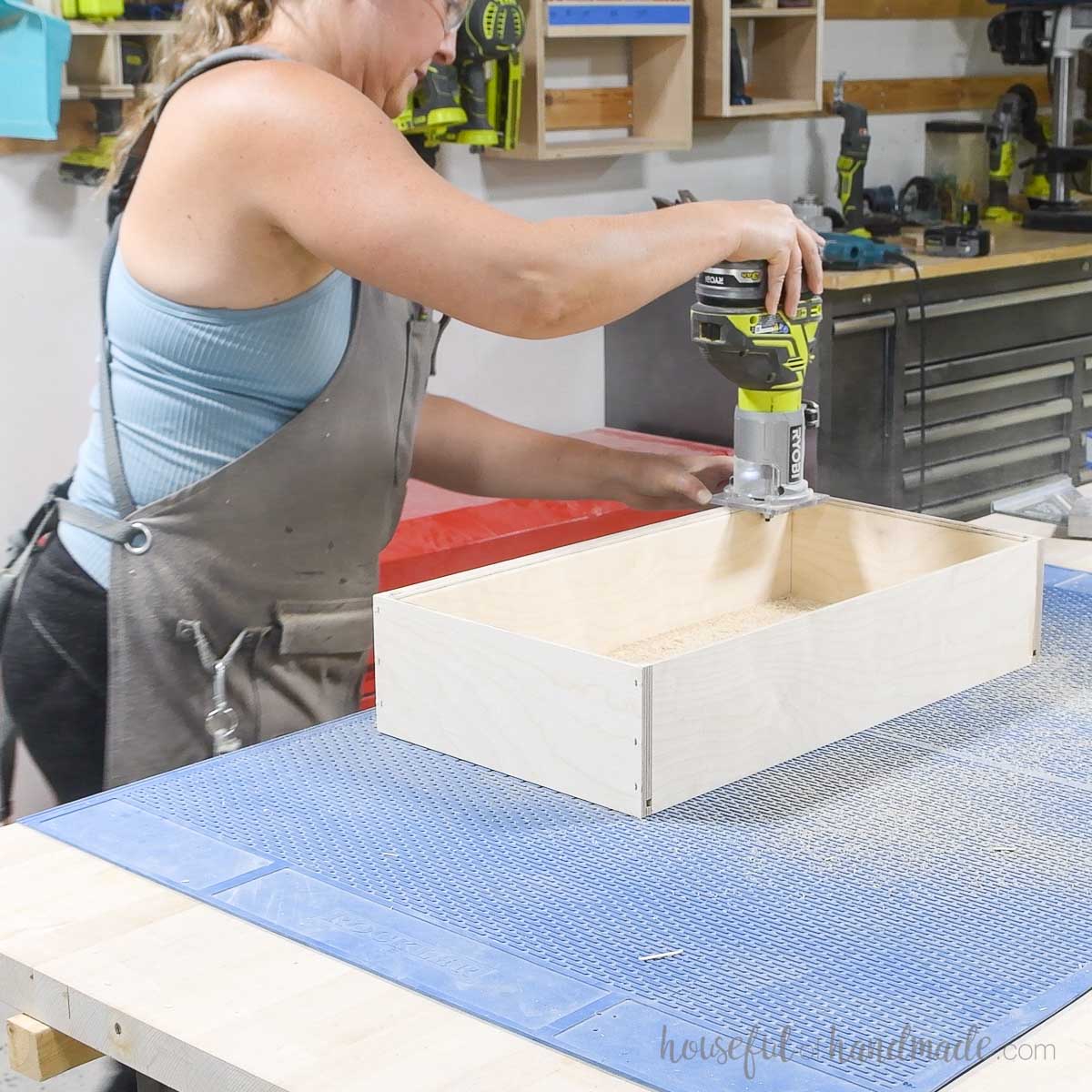
STEP 4- Install drawers boxes and fronts
Install the drawer boxes using the 12″ long drawer slides so the drawer boxes are set back 3/4” from the front of the front trim pieces (1” back from the front of the legs).
The drawer boxes should be 1/4” up from the bottom of the drawer opening, leaving 3/4” clearance on the top.
Learn how to install drawers with ball bearing slides here.
EXPERT TIP:
Clamp a scrap of 3/4″ plywood on top of the front frame. Make sure it is level and clamp at the back of the nightstand. Then set your drawer slides on top of it while you secure them. This will keep your slides level inside the nightstand.
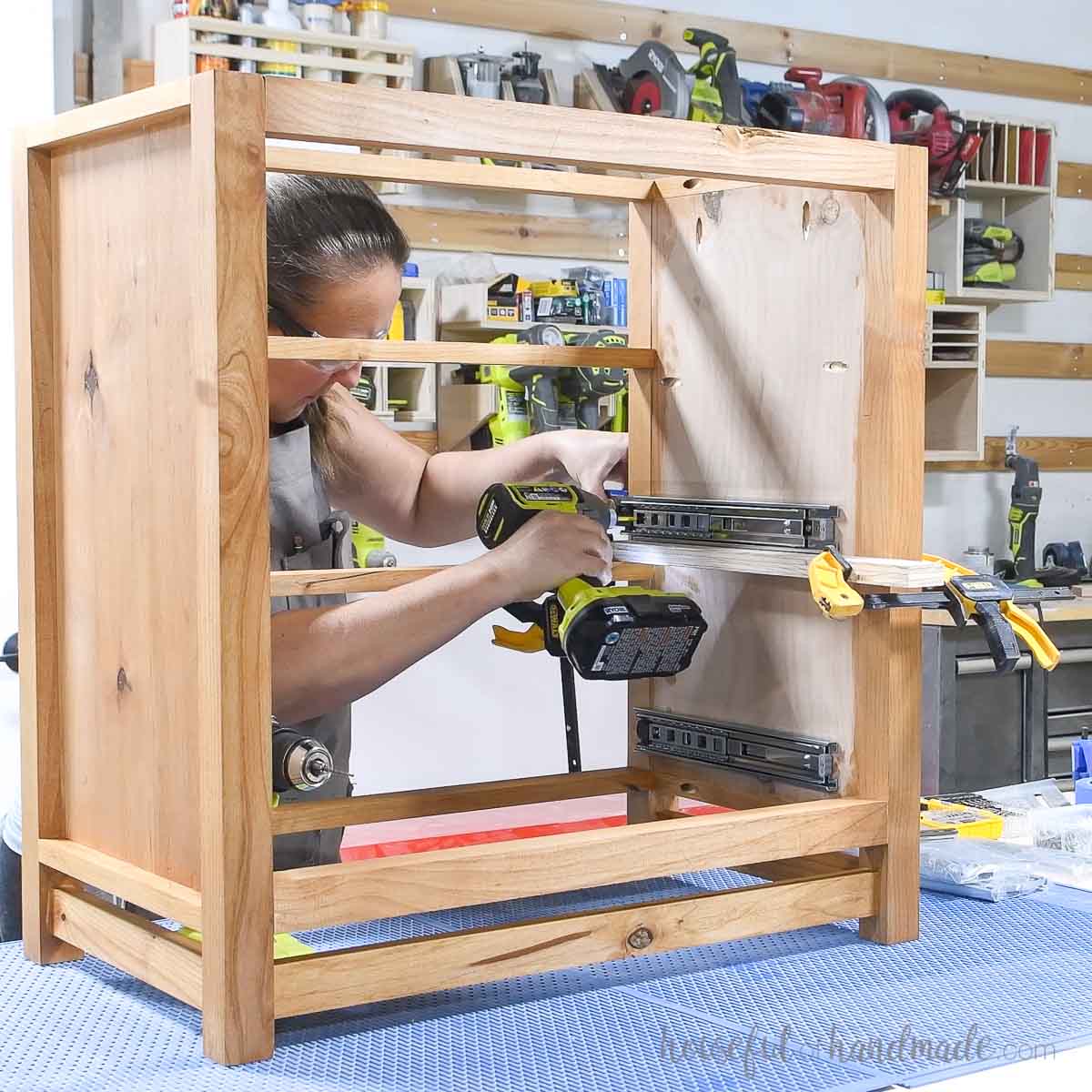
Attach the smaller part of the drawer slides to the side of the drawer box.
I spaced them 7/8″ up from the bottom of the box to give me the correct clearance once installed. Make sure to measure and adjust for your specific drawer slides.
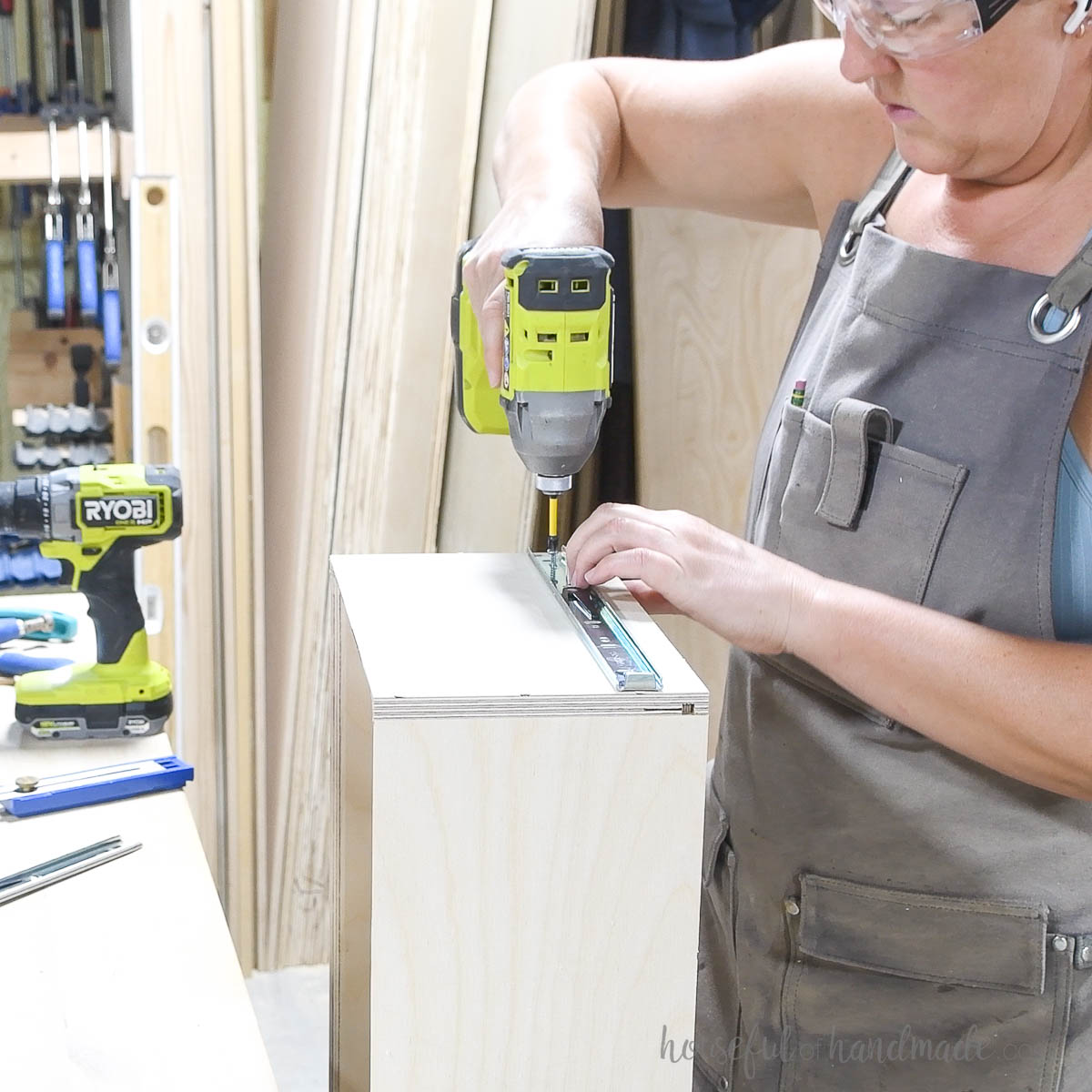
Attach the drawer fronts so they sit inside the frame and are flush to the front. There should be a 1/8” gap all the way around the drawer fronts.
Once the drawer front was lined up (use 1/8” spacers or playing cards to get the perfect reveal), I used a brad nailer with 1” nails to temporarily attach the drawer front from the inside of the drawer.
Or you can use my trick for installing drawer fronts using the drawer pulls.
Then permanently attach the drawers using 1” wood screws from the inside of the drawer. Use (4) screws per drawer, one screw in each corner of the drawer box front.
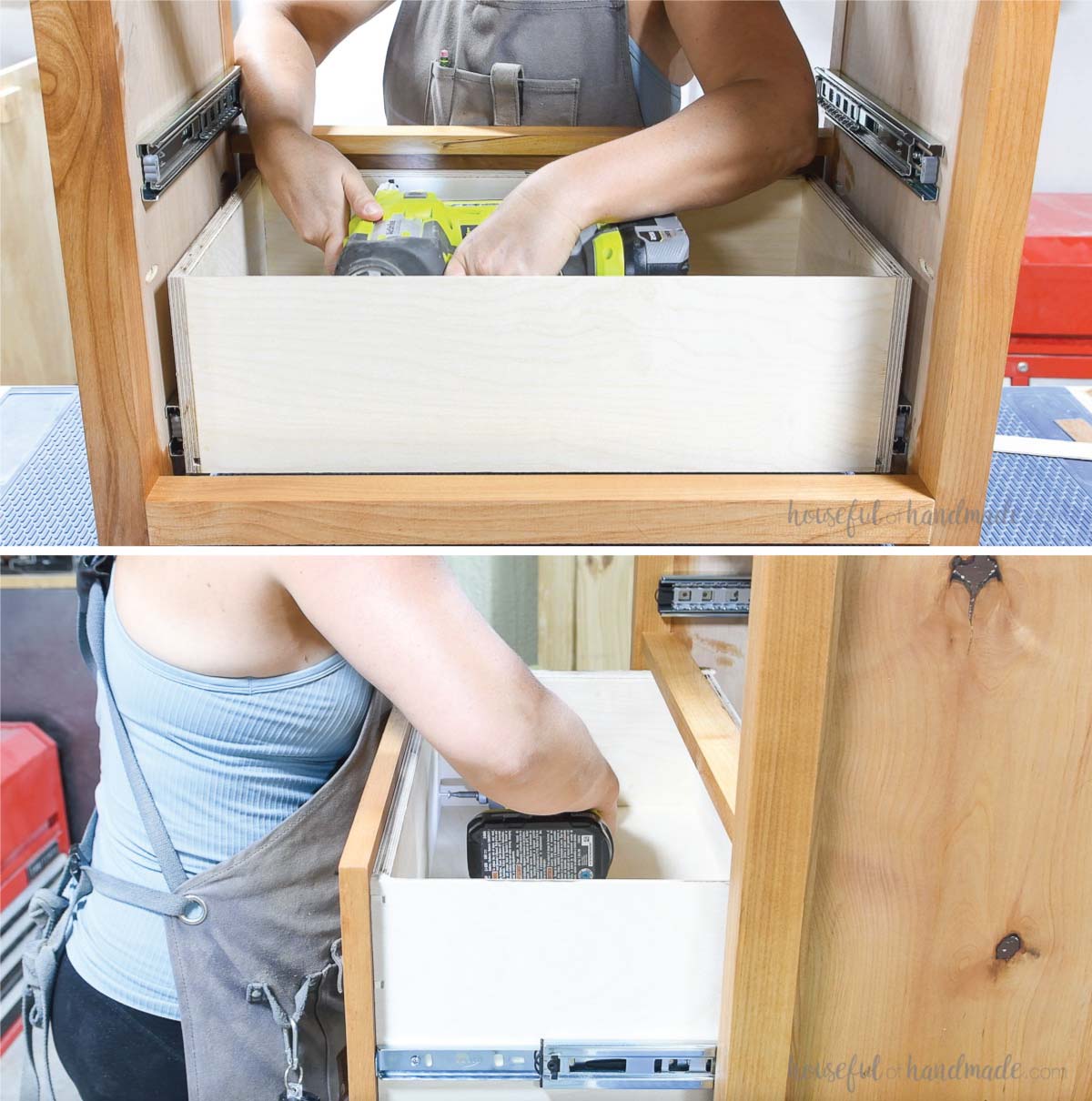
Add your desired drawer pulls. I used a small 1” black pull on the smaller drawers and a large 3″ drawer pull on the lower drawer fronts.
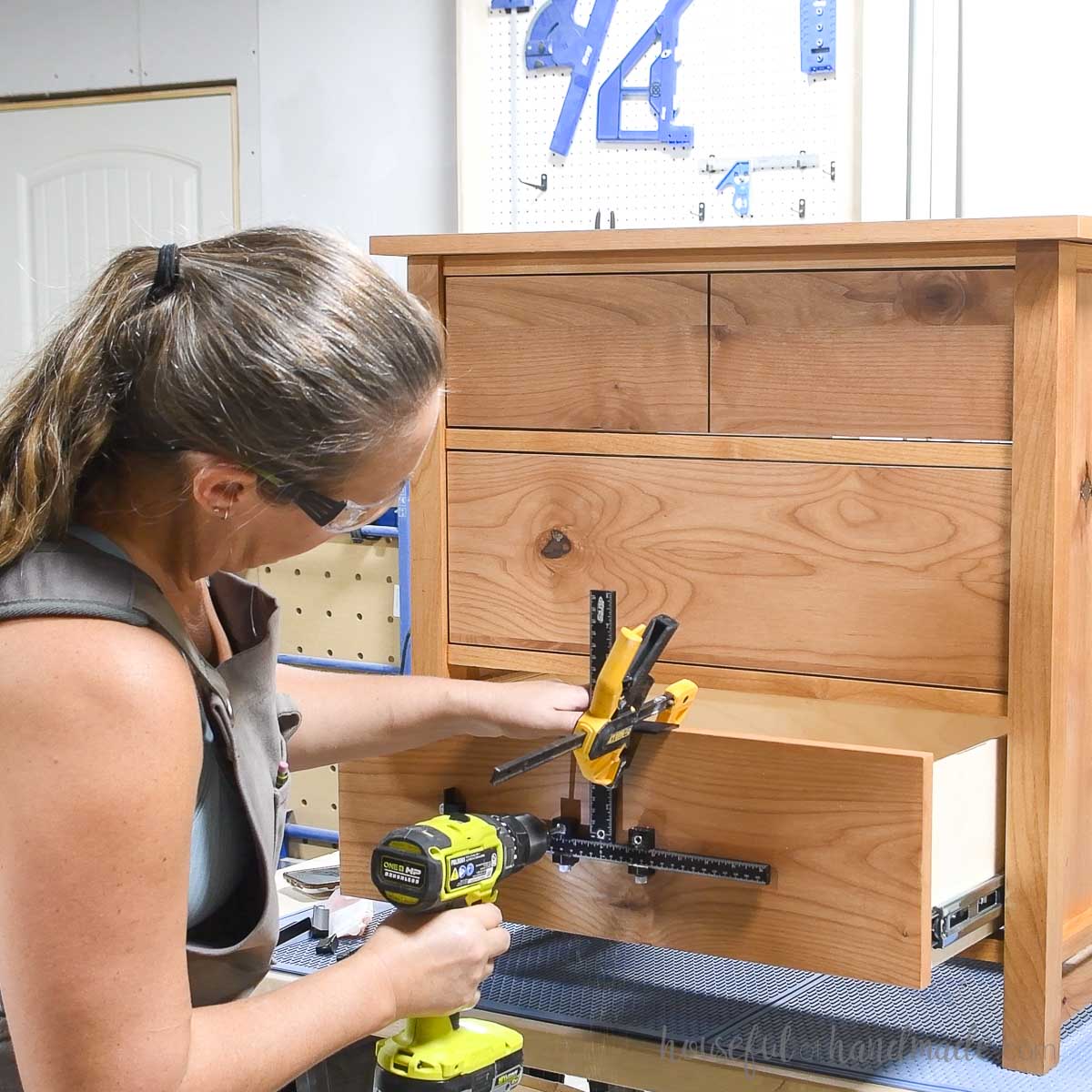
STEP 5- Attach top and finish
I prefer to attach the top last so that you can easily access the inside of the drawers while installing them. So first, remove all the drawers, make sure to label them. I wrote their location on the back of the drawer box.
Place the top on your work table and then place the dresser frame upside down on top of it. The top should be flush with the back of the dresser frame and hang over the sides and front 1”.
Drill 1/4” deep countersunk holes in the top of the frame. Add 3 holes in the front and 3 in the back.
Attach the top with 1” screws in the holes on the front and 2” long wood screws in the back.

You did it!
Premium plans include:
- Recommended Tools
- Shopping list
- Easy to read cut list table
- Cut diagrams
- Step-by-step instructions with 3D renderings
- Helpful resources
- BONUS: 3D SketchUp file
Place your new nightstand next to your bed and sit back and relax. Now you have the perfect place for everything you need.
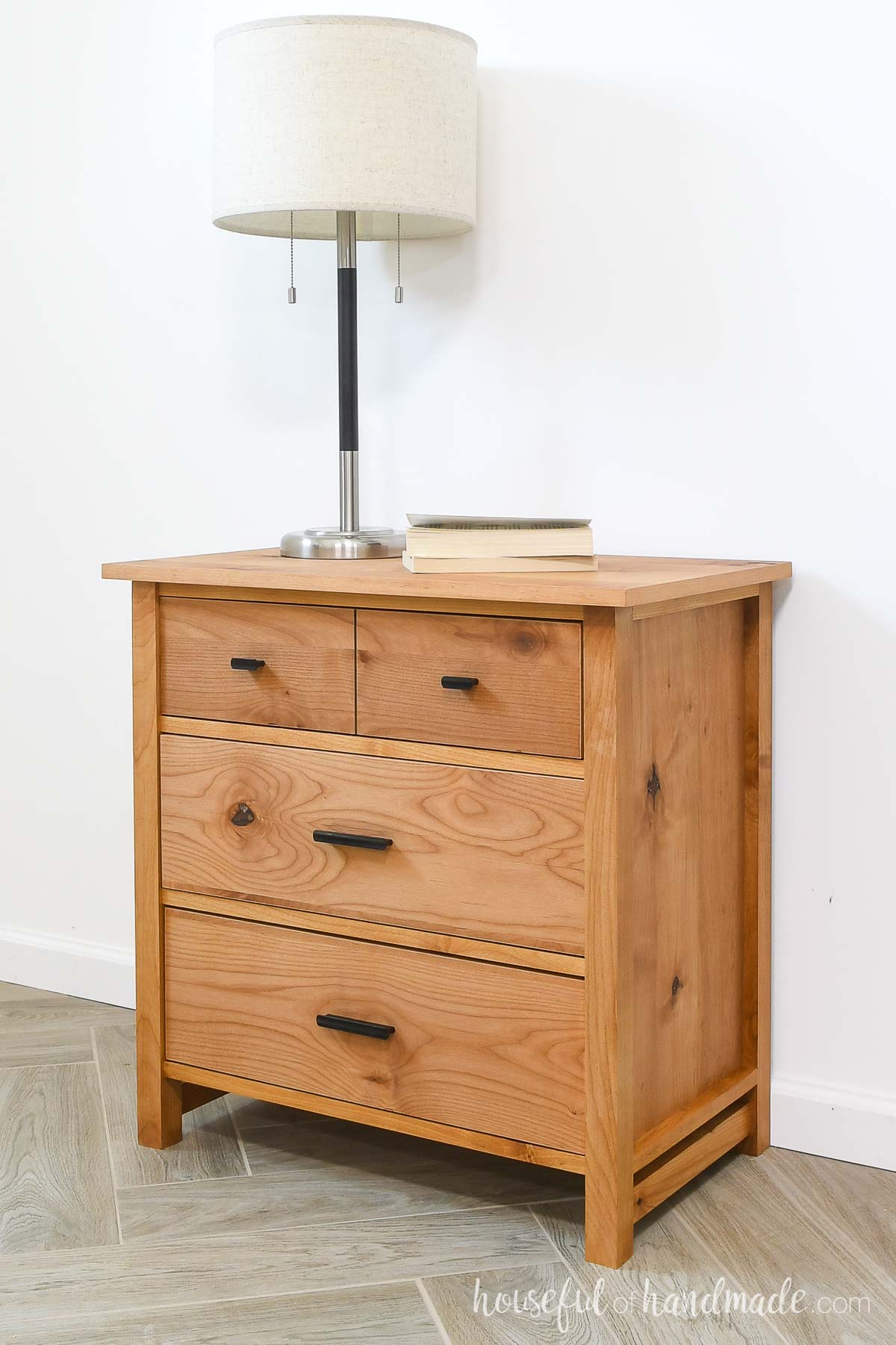
Happy building!


